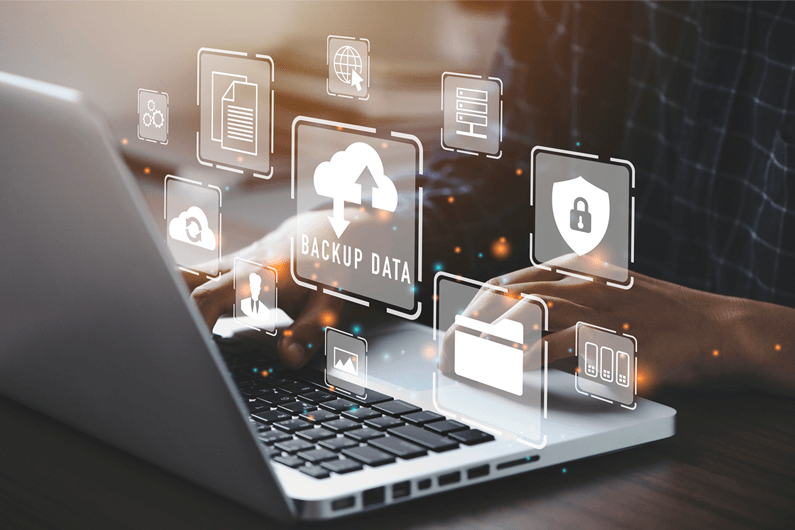
How to Protect Data Against Hackers
Either on-site or in the cloud, backups can keep your information safe and secure from potential hackers.
While cybercriminals that specialize in hacking attacks tend to target businesses, individuals are increasingly at risk as well. By one estimate, ransomware attacks cost individual internet users more than $49 million a year.
All too often, consumers fall prey to phishing emails—which claim to be from a known person or organization but aren’t—as well as drive-by downloading, in which users visit infected websites that surreptitiously download and execute malware. Threat actors often lure individuals to these sites by using search engine optimization poisoning, a technique that manipulates keywords to raise search rankings of malicious sites to make them seem legitimate. Users often click top search results without paying attention to the actual address and, once there, may enter personal information or download malware.
It takes just one wrong click to trigger a series of actions that encrypts data to make it inaccessible to the user—until they pay a ransom. Additionally, while ransomware attacks have traditionally targeted computers, the ubiquity and increasingly powerful capabilities of mobile devices has spurred bad actors to create malware designed to infiltrate and compromise smartphones.
Consequences of a Ransomware Attack
No matter the device, the consequences of a ransomware attack can be significant and very personal. A successful attempt can leave users with a blank hard drive that erases their digital life. Irreplaceable personal data, family photos, and legal and financial records disappear. To make matters worse, this information is often sold on the dark web, opening the door for hazardous leaks of personal information that can enable credit card fraud and identity theft.
The good news is that safeguarding your personal data isn’t difficult—provided you have a backup plan in place. Whether you backup your data to the cloud or to external storage devices, you should follow the lead of businesses by creating and implementing a written strategy. Doing so can help safeguard your backups from ransomware attacks and also quickly restore your data should one occur.
The Basics of Backups
For individual users, disciplined backups represent the most effective way to fend off ransomware attacks. You have two primary backup strategies to consider: Use your own equipment to make and manage backups or upload your data to cloud services for automatic backups.
When developing any backup plan, following the tried-and-true 3-2-1 strategy is often recommended. This rule requires storage of three copies of all data files: The original file, an on-site copy written to a different device like an external hard drive, and an off-site copy. Most computer vendors offer built-in tools that automate backups to external storage or the cloud. The Windows 11 operating system, for instance, enables users to create a system image and automatically back up and restore all programs and files. Backups can be stored on an external hard drive, removable media, a local area network, or Microsoft’s cloud-based OneDrive storage.
Another option is installing third-party backup software. These more advanced solutions allow you to centralize and remotely manage data, whether in the cloud or on a range of storage devices that include external drives, solid-state storage, recordable optical media, and USB flash drives.
Aside from backing up your phone, it’s a good idea to utilize additional security resources from your bank, if available. Fifth Third Identity Alert® is a great example of how Fifth Third Bank customers can rest assured, knowing they receive daily credit monitoring, social security monitoring, email and text alerts, and much more. Apply today.
Making a Case for Cloud Storage
Established cloud service providers offer a range of built-in tools that consolidate secure storage, automated data backups, data management capabilities, and built-in security precautions. Cloud storage can be used as a primary or secondary backup.
Cloud-based backup offers a number of advantages. For one, you only need an internet connection and a smartphone to access backups from anywhere. Cloud services can store—and encrypt--all types of files, photos, and data. Most cloud providers offer scheduled backups, both full and incremental, to help you effortlessly preserve your data. Popular cloud service providers include Microsoft OneDrive, iDrive, Google Drive, Dropbox, iCloud, and Sync.com.
In addition, established cloud providers also offer built-in cybersecurity protections against data breaches. You’ll pay a monthly fee for cloud storage, depending on the quantity of data stored and the services used.
What to Always Remember
In the end, much of the responsibility for data protection lies with you and other users within your digital domain. You’ll need to stay up to date with evolving phishing and social engineering tactics associated with ransomware. Always be vigilant: Think twice before clicking email attachments from unknown recipients, websites, and social networking profiles. Never disclose personal information to unauthorized individuals.
Most importantly, backup your devices at least once a day to ensure your information is safe and up-to-date.